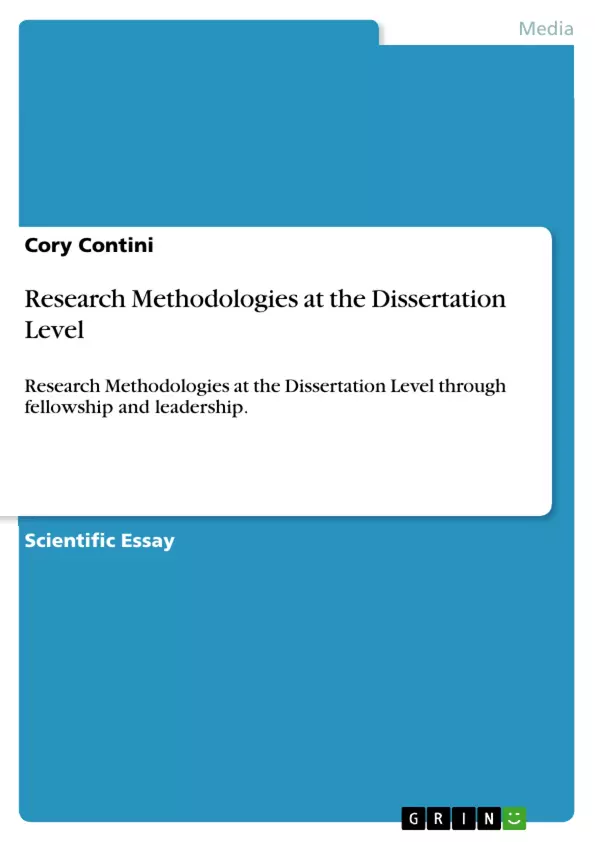Identifying applicable research strategies at a level suitable for dissertations is almost as difficult as the process of conducting and completing a dissertation-level research experiment. Methodology tends to differ according to the various factors found within the desired outcome. Yet methods cannot be orchestrated to generate this outcome from the data, but merely facilitate its collection and synthesis. Any successful research methodology does not, therefore, create knowledge, but rather is an applicable strategy for identifying and processing the information which exists.
Hathaway (1995) stresses that there are decisions embedded within the creation and conduct of research methodologies that are generated both within the research setting and within the perceptions of the researcher. The concept of an unbiased methodology is thus inherently impossible: All researchers come to the experimentation process with preconceived opinions of how and why the research process should transpire. The selection and application of methodology thus serves two practical stages: First, the research methodology is selected with the end result in mind, and is believed by the researcher to reveal the data which already exists in a clear and uncontestable format. Second, the research methodology creates a barrier between the researcher and the data. This last point is of particular significance. If the researcher acquires and applies a methodology that is suitable to the research process, than the data will naturally emerge and be presented in a manner that removes the biases of the researcher.
In order to demonstrate a familiarity with how, why, and to what extent specific forms of methodology are effective in conducting dissertations, this paper shall provide a basic overview of standard methods used in research studies. The focus of this paper is on comparing and contrasting the differences between qualitative, quantitative and mixed research methodologies. To further explore the effectiveness of these strategies, each will be evaluated as a method for measuring followership qualities in a medical facility.
Inhaltsverzeichnis (Table of Contents)
- Introduction
- Qualitative Research Strategies
- Qualitative Data and Followership in Medical Communities
- Quantifiable Research Strategies
- Quantifiable Data and Followership in Medical Communities
- Mixed Research Methodologies
- Mixed Research Methodologies and Followership in Medical Communities
- Conclusion
Zielsetzung und Themenschwerpunkte (Objectives and Key Themes)
This paper offers a comprehensive overview of standard research methods used in dissertations, particularly focusing on qualitative, quantitative, and mixed research methodologies. The paper aims to compare and contrast the strengths and weaknesses of these approaches and to explore their effectiveness in measuring followership qualities within a medical facility.
- Comparing and contrasting qualitative, quantitative, and mixed research methodologies.
- Evaluating the effectiveness of these methodologies for studying followership in medical settings.
- Highlighting the debate surrounding the validity and applicability of different research approaches.
- Exploring the concept of followership and its influence on employee behavior and performance.
- Analyzing the challenges and advantages of implementing leadership strategies within a healthcare environment.
Zusammenfassung der Kapitel (Chapter Summaries)
The Introduction outlines the complexities of selecting and applying research methodologies at the dissertation level, emphasizing the influence of both research setting and researcher bias. The paper then focuses on three primary research approaches: qualitative, quantitative, and mixed methods.
The section on Qualitative Research Strategies discusses the criticisms and strengths of qualitative research. It highlights the importance of understanding human perception and emotional content in research, particularly in areas like followership in healthcare settings. The chapter provides examples of how qualitative research methods, such as semi-structured interviews, can be used to gather valuable insights into employee perspectives.
Quantifiable Research Strategies are discussed in the next section. The chapter explores the advantages and limitations of quantitative research, emphasizing the importance of numerical data and its potential to be misinterpreted. The authors then delve into the application of quantitative research in studying followership within medical communities, focusing on the use of performance measurement and feedback systems to assess employee productivity and responses to changes in leadership.
The section on Mixed Research Methodologies examines the merits of combining qualitative and quantitative approaches to address the shortcomings of each individual method. The chapter highlights the different types of mixed methods research designs, including convergent and sequential methodologies. The authors provide examples of how mixed methods research can be applied in healthcare settings to gain a holistic understanding of leadership and followership dynamics, considering both human and statistical factors.
Schlüsselwörter (Keywords)
The primary keywords and focus topics of this text include research methodologies, dissertation research, qualitative research, quantitative research, mixed methods research, followership, leadership, healthcare, employee behavior, performance measurement, and organizational change.
- Citar trabajo
- Cory Contini (Autor), 2009, Research Methodologies at the Dissertation Level, Múnich, GRIN Verlag, https://www.grin.com/document/230613



